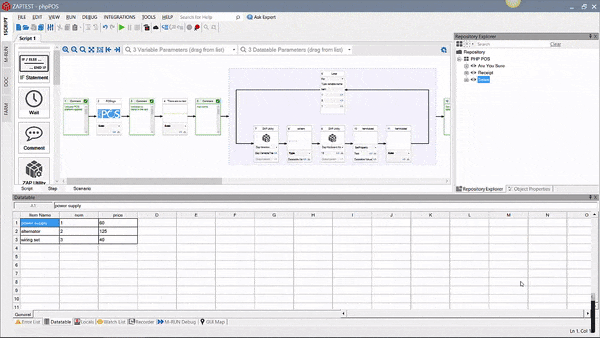Incremental testing in software testing is a methodology that allows teams to break down individual modules, test them in isolation, and integrate them in stages. It helps find defects early, reduces complexity, and increases test coverage.
This article will take a deep dive into incremental testing, explain what it is, and explore the different types, processes, approaches, tools, and more that are associated with this useful methodology.
What is incremental testing?
Testing is one of the most important stages of the software development life cycle (SDLC). Just like with the SDLC, testing is broken down into different logical steps. Incremental testing is one of these stages, and it typically occurs during integration testing and right after unit testing.
Incremental testing is a pragmatic software testing approach that breaks down large or complex programs into manageable, bite-sized chunks. Instead of integrating and testing an entire software system at once, incremental testing looks at modules and implements a phased verification process.
Software modules are typically self-contained units of code that perform specific tasks or functions. How granular these modules are depends on various factors, such as coding practices, development methodologies, or even the programming language that you use.
Modules are tested independently during unit testing. Then, during integration testing, each module is integrated piece by piece — or in increments. This process ensures that each module works well together. However, to fully verify each module, testers need to simulate components that have yet to be implemented or external systems. To do this, they need the help of stubs and drivers.
What are stubs and drivers in incremental testing?
Stubs and drivers are critical software testing tools. These temporary pieces of code are used during integration testing because they offer teams the ability to mimic the behaviors and interfaces of various modules or components.
1. Stubs:
Stubs mimic modules that have yet to be developed and are, as such, unavailable for testing. They allow the module under test (MUT) to call upon incomplete modules. The upshot here is that the MUT can be tested in isolation, even when related modules are not available.
2. Drivers:
Drivers, on the other hand, simulate the behavior of modules that call the MUT. Within the testing environment, these drivers can send the MUT test data. Again, this facilitates testing modules in isolation without the need for external dependencies.
Using stubs or drivers reduces development time, improves code quality, and increases team productivity. However, deciding which one to use depends on which testing methodology is most appropriate. We will expand on this in a section below dealing with the different types of incremental integration testing.
Different types of incremental
integration testing
Incremental testing types can be broadly split into three categories. Let’s explore each one.
1. Top-down incremental integration
Top-down incremental integration starts by testing the highest-order modules within a system. From there, it gradually integrates and tests lower-order modules.There are two main scenarios where top-down incremental integration is used. They are:
- When a system is very large or highly complex
- When the dev team is working on many modules at the same time.
Steps for top-down incremental integrations
- Identify critical modules
- Create stubs to mimic lower-order modules
- Develop drivers to interact with the higher-order modules to send them data and interpret the module’s outputs
- Unit test critical modules with drivers and stubs
- Integrate lower-order modules and gradually replace stubs with real implementations
- Refactor drivers to accommodate the new modules
- Repeat until all lower-order modules are integrated and tested.
2. Bottom-up incremental integration
Bottom-up incremental integrations go in the opposite direction. With this approach, the lower-order (or least critical) modules of the system are tested, with higher-order modules gradually added. This approach is suitable in different scenarios, such as:
- When you deal with smaller systems
- When a system is modularized
- When you have some concerns about either the accuracy or the completeness of stubs.
Steps for bottom-up incremental integrations
- Identify lower-order modules
- Unit test lower-order modules to verify their individual functionality
- Develop drivers to act as intermediaries with lower-order modules
- Create stubs to simulate the behavior of higher-order modules
- Integrate the next modules, from lower to higher order, and gradually replace stubs with real implementations
- Refactor drivers to accommodate the new modules
- Repeat until all higher-order modules are integrated and tested.
3. Functional incremental integration
Function incremental integration testing is the next common type of incremental testing in software testing. While the two previous kinds focused on higher and lower-order modules, functional incremental testing is based on the functionality of a particular module.
Functional incremental integration is used in Agile/DevOps methodologies, and it’s an excellent choice for applications with complex dependencies between modules or components.
Steps for functional incremental integration
- Identify individual modules and components with well-defined interfaces
- Verify the functionality of each module via unit testing
- Integrate the most minimal core modules of the system and ensure it functions
- Gradually add single modules, testing functionality at each step
- Refactor the code as each module is added
- When all modules are added, test functionality and performance
Pros and cons of an incremental testing approach
By now, you should have some idea why incremental testing is a popular approach. However, like all software testing methodologies, it has its advantages and disadvantages. Let’s explore some of these pros and cons.
Pros of an incremental testing approach
1. Flexibility
As all software developers and testers know only too well, requirements can change and evolve during the SDLC, sometimes quite dramatically. Incremental testing is dynamic enough to allow teams to adapt during the testing process and incorporate new plans and directions.
2. Early bug detection
The best time to detect a bug or defect is as early as possible. When developers verify bite-sized modules individually, identifying and fixing problems is far easier. What’s more, it helps mitigate the likelihood of big issues occurring late in development.
3. Simplicity
Software testing can be a highly complex process. One of the most compelling aspects of incremental testing is found in how it breaks testing town into workable parts. Instead of dealing with overwhelming complexity, testers can focus on and even prioritize particular modules. This benefit is a godsend for large and complex applications.
4. Lower regression risk
Regression is a time-consuming and complex issue within software development. Incremental testing can mitigate the frequency and risks caused by regression because it allows teams to test modules individually and deal with issues as they occur. When used with solid regression testing, teams can save a lot of time and heartache.
5. Feedback opportunities
A frequently overlooked benefit of incremental testing is that it allows teams the latitude to put together prototypes and MVPs. From there, stakeholders and investors can assess the basic functionality of the process and provide invaluable feedback. This situation can save a lot of time and money and lead to more robust products.
Cons of an incremental testing approach
1. Integration issues
Testing modules separately is desirable because it breaks down a complex application into manageable chunks. However, integrating these modules can result in new and unexpected errors. As such, an incremental testing approach must be carefully and deliberately planned.
2. Test suite complexity
With multiple test cases for each module and their respective interaction with each other, test suites can become complex to track and manage. For large and complicated apps, this makes thorough documentation or test management tools a necessity.
3. More work
Monolithic testing, while more complex, requires less testing. By testing lots of modules separately, incremental testing does require more work. However, the benefits of incremental testing, such as the early discovery of bugs, mean that extra effort is a time-saving investment. Of course, software test automation can help reduce these efforts.
4. Increased management demands
Incremental testing requires multiple teams to work together. For example, development, testing, and DevOps teams will need to work in concert. This situation creates additional management demand and requires good communication between these teams to ensure they are focused and pulling toward the same objectives.
Incremental testing example
Perhaps the easiest way to understand an incremental testing approach is to think about an example. Here is a simple situation to help visualize the process.
1. Incremental testing example for a mobile banking app
Scenario: A team is building a mobile banking app. The app is composed of several different modules that enable:
- 2FA and biometric user verification
- Transaction processing
- Financial data management dashboard
Objective: The team wants to test the integration of each module and determine if they work well together. As a result, they build three test cases.
Test case 1
In the first test case, the team wants to ensure that by entering biometric or password data, the user will gain access to both transaction processing and the financial data management dashboard.
The app will pass the test if the user can enter their details and gain the ability to access transactions.
Test case 2
The next test case is designed to see how the app handles unauthorized transactions.
The app passes the test if an attempt to make an unauthorized transaction is blocked and the app produces an error message.
Test case 3
The final integration test involves validating if the app can make transactions concurrently.
The app will pass the test if the user can start a transaction and access their financial information at the same time without any data inconsistencies or problems.
Is an incrementality testing approach the
same as incremental testing?
No. Incrementality testing refers to a statistical marketing method that is perhaps best known as attribution modeling. In short, it helps marketing teams understand the impact of advertising campaigns, marketing channels, or particular strategies.
While interest in this kind of modeling has grown in recent years thanks to the “death” of cookies and third-party data, the only relation it has to incremental testing is a shared word.
Top 3 tools for incremental testing
#1. ZAPTEST
As well as providing first-class RPA capabilities, ZAPTEST offers a range of software testing automation tools that are perfect for incremental testing. Some of the features include:
- Test data management: Reduce the amount of time and effort involved with incremental testing by allowing teams to reuse test data
- Script recording and playback: This no-code tool allows teams to record and execute scripts and save a lot of time during incremental testing
- Reusable test modules: ZAPTEST is highly modular and allows teams to create and reuse test modules and shave significant amounts of time off the testing process.
All in all, ZAPTEST offers a powerful and varied test automation suite that is suitable for any type of testing, including incremental testing.
#2. Selenium
Selenium is an open-source test automation platform that is built to facilitate mobile application testing. The tools support several mobile platforms (Android, iOS, Windows) and uses stubs and drivers to simulate modules.
#3. Testsigma
Testsigma is a cloud-based test automation platform. It can be used to test web and mobile applications and is suitable for incremental testing thanks to codeless test creation and integration with CI/CD pipelines.
Final thoughts
Incremental testing in software testing is an important part of integration testing. It allows teams to break down modules into easily testable parts before slowly integrating them. The benefits here are that each module can be verified for bugs and then for how it integrates with its connected parts.
Alongside our best-in-class RPA tools, ZAPTEST offers no-code software test automation that is both cross-platform and cross-application. Moreover, our testing suite comes packed with features like CI/CD integration, robust reporting and analytics, and first-class support and customer service.









